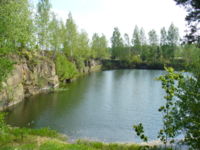
Photo from wikipedia
[A seismic wedge (red) which is part of a clinoform complex (orange, brown and yellow) was recently drilled for the first time. The well encountered gascharged marine siltstones. Quantitative clinoform… Click to show full abstract
[A seismic wedge (red) which is part of a clinoform complex (orange, brown and yellow) was recently drilled for the first time. The well encountered gascharged marine siltstones. Quantitative clinoform characterization, seismic stratigraphy and regional geology support the interpretation of further potential sandtone reservoirs within the targeted clinform complex. , Abstract Sandy clinothems are of interest as hydrocarbon reservoirs but there is no proven, economic, clinothem reservoir in the Norwegian Barents Sea. We used high‐resolution, 2D and 3D seismic, including proprietary data, to identify a previously untested, Barremian, clinoform wedge in the Fingerdjupet Subbasin (FSB). Data from recent well 7322/7‐1 plus seismic have been used to characterize this wedge and older Lower Cretaceous clinoforms in the FSB. In the latest Hauterivian – early Barremian, during post‐rift tectonic quiescence, shelf‐edge clinoforms (foreset height > 150 m) prograded into an under‐filled basin. Increased sediment input was related to regional uplift of the hinterland (northern Barents Shelf). Early Barremian erosion in the north‐western FSB and mass wasting towards the SE were followed by deposition of delta‐scale (<80 m high), high‐angle (c. 8°) clinoform sets seaward of older shelf‐edge clinoforms. This may be the local expression of a regional, early Barremian, regressive event. By the close of the Barremian, clinoforms had prograded, within a narrow, elongate basin, across the FSB and towards the uplifted Loppa High. A seismic wedge of high‐angle (10–12°), low‐relief, delta‐scale (25–80 m) clinoform sets occurs between shelf‐edge clinoforms to the NW and the uplifted area to the SE. Well 7322/7‐1, positioned on a direct hydrocarbon indicator, <1 km NNW of the high‐angle, low‐relief, delta‐scale clinoforms, found upward coarsening siltstone‐cycles linked to relative sea‐level fluctuations on a marine shelf. Sand may have accumulated, offshore from the well, in high‐angle, low‐relief foresets of the delta‐scale clinothems (which are typical geometries elsewhere interpreted as ‘delta‐scale, sand‐prone subaqueous clinoforms’). Deposition was controlled by the paleosurface, storms and longshore currents on an otherwise mud‐dominated shelf. The study highlights challenges associated with exploration for sandstone reservoirs in seismic wedges on an outer shelf.]
Journal Title: Basin Research
Year Published: 2020
Link to full text (if available)
Share on Social Media: Sign Up to like & get
recommendations!